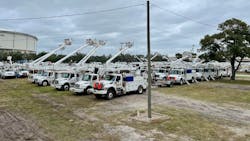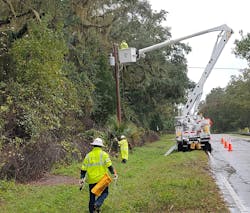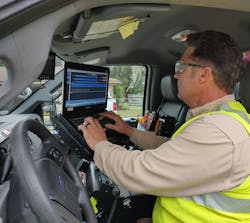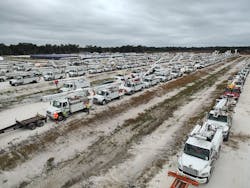Line Crews Unite to Rapidly Restore Power After Nicole
Hurricane Ian roared into Florida as a Category 4 storm in late September. Just a few weeks later, at around 3 a.m. on Nov. 10, Nicole made landfall as a Category 1 hurricane on Florida’s east coast. It then moved through the state as a strong tropical storm.
While Nicole inflicted less damage to Duke Energy Florida’s infrastructure than Ian, the storm still impacted a large portion of the utility’s service territory. As the first hurricane to make landfall in Florida in November since 1985, Nicole brought damaging rain and heavy winds to Duke Energy's service territory.
“Every storm is different with the damage it brings,” said Barry Anderson, Duke Energy Florida’s senior vice president of customer delivery. “After Nicole, we saw downed power lines due to trees and some broken poles.”
In the aftermath of Nicole, crews rapidly responded and restored 300,000 of the impacted customers within the first 12 hours. To get the lights back on swiftly and safely, it required year-round planning and training combined with sustained investments in a stronger, smarter, more storm-resilient energy grid.
“While we did not anticipate a hurricane so late in the season, our team didn’t hesitate to respond and support our customers,” said Anderson. “Nicole impacted a large portion of our territory, and the incredible team effort helped us restore 98% of our impacted customers within 12 hours of Nicole leaving our service territory.”
Planning Ahead
To take a proactive approach to storms like Nicole, Duke Energy Florida focuses on preparedness year-round. In turn, the utility can minimize the impact of storms and ensure the safety of its customers, communities and crews.
Duke Energy has a comprehensive storm response plan built upon decades of experience and improvement. Advanced forecasting and damage modeling processes help the company strategically place crews, support resources and equipment ahead of the storm to respond quickly as outages occur.
For example, a team of meteorologists tracks weather conditions and models resource needs to ensure the utility is prepared to react quickly when the power goes out. Prior to every storm, the company also ensures that equipment, supplies and inventories in all areas that could be impacted are readily available to make necessary repairs and restore power outages.
For Hurricane Nicole, Duke Energy Florida’s logistics team supported placement of workers across the state to respond quickly and safely once the storm passed. These crews came from Duke Energy’s Ohio, Kentucky and Carolinas operations—as well as workers from other utility companies based in Arkansas, Georgia, Louisiana, Missouri, Tennessee and Virginia, among other states.
“Our team was well-prepared and poised to respond to Hurricane Nicole with more than 5,000 workers—power line technicians, damage assessors, vegetation workers and support personnel—across the state ready to respond to power outages,” he said . “Many of those workers came from as far as the Midwest, Louisiana and the eastern portion of the country to answer the call to assist Duke Energy Florida in getting the lights back on for the customers.”
During every storm, the utility’s first priority is to restore power to the greatest number of customers as safely, quickly and efficiently as possible. For Hurricane Nicole, Florida-based crews, along with the reinforcements, helped speed restoration.
“With significant progress made during the first day the storm made landfall, the company was able to place a greater concentration of crews in areas where the impacts from the storm were still being felt,” Anderson said. “Along with additional crews, the company was helped by its recent improvements to the grid, minimizing outages and restoration times.”
Expediting Restoration
After every storm, safety is the utility’s primary concern. Restoration cannot begin until the storm has passed and the workers can safely access impacted communities. For Hurricane Nicole, strong winds posed a particular challenge. For employee safety, crews didn’t perform elevated work in bucket trucks when winds were above 30 miles per hour.
“As the storm made its way through our service area and weather conditions improved, crews began damage assessment and repairs right away,” Anderson said.
The company’s damage and resource modeling enabled Duke Energy Florida to stage crews near areas that would likely be affected by this system.
“This allowed for the quickest and safest response after the storm passed through our service territory,” Anderson said.
Damage assessment, which is the first step of storm restoration, not only involves ground crews, but also aerial surveillance helicopters and drones in hardest-hit areas. That assessment determines where the company will deploy its workers, equipment and other resources to begin the complex job of power restoration once the storm passes.
After a storm, previous technology forced crews to physically inspect miles of power lines to ensure that everyone’s power was restored, which was very time consuming, Anderson says. Today, Duke Energy Florida crews can use a technology called Ping-it to remotely confirm an outage in seconds. Ping-it sends a signal to each smart meter to ensure that repairs successfully restore electricity to everyone, without ever rolling a bucket truck. In Florida, Duke Energy has installed nearly 2 million smart meters that enable this technology.
Additionally, the company continues to invest in enhancements such as self-healing grid technology, utility pole and power line upgrades and targeted undergrounding of power lines to reduce power outage frequency and duration during extreme weather events and to enhance overall reliability for our customers.
Investing in Technology
Duke Energy Florida is making strategic improvements across the state to strengthen the grid against outages from severe weather. In addition, the utility is striving to improve resiliency to restore power faster when outages occur.
“Grid strengthening work further enhances Duke Energy Florida’s storm response,” Anderson said. “The company installs stronger poles and upgrades wires, places outage-prone lines underground, trims vegetation near power lines and installs self-healing technology that can automatically detect power outages and reroute power to other lines to restore power faster.”
Much like a GPS can reroute traffic during an accident, self-healing technology can automatically detect power outages and quickly reroute power to restore service faster or avoid the outage altogether. The technology provides a smart tool to assist crews in the field with power restoration after a storm like Nicole, helping reduce outage impacts and freeing up resources to help restore power in other locations.
“Over the years, Duke Energy’s smart, self-healing technology has provided tremendous benefit to Florida customers,” Anderson said. “Duke Energy currently serves nearly 60% of customers in Florida with self-healing capabilities on its main power distribution lines, with a goal of serving around 80% over the next few years.”
Case in point: during Hurricane Nicole, the technology automatically restored around 55,000 customer outages, saving 13.4 million minutes of total outage time. During Hurricane Ian, the technology automatically restored more than 160,000 customer outages and saved nearly 200 million minutes of total lost outage time. Prior to that in 2021, self-healing technology helped avoid nearly 250,000 extended customer outages in Florida, saving around 17.1 million minutes of total lost outage time.
Additionally, Duke Energy Florida has reduced the average amount of time a customer experiences an outage by about 20% over the last five years, according to the System Average Interruption Duration Index (SAIDI), which indicates the amount of time the average customer experiences a sustained outage.
Focusing on the Future
Another key to Duke Energy’s ability to streamline and expedite restoration is partnering with peer utilities, which provide additional resources to shorten response times and get communities back on their feet faster.
“This collaboration is increasingly important as we continue to face storms that are growing in frequency and severity,” Anderson said. “We are working hard to deliver electricity that is reliable, increasingly clean and more secure, while also providing more value every single day. We know that storms are increasing in frequency and intensity, so it’s important that we take steps today to protect the grid from the impacts of severe weather and increase reliability for all our customers.”
To build a smarter energy future for its customers and plan ahead for storms like Hurricanes Ian and Nicole, Duke Energy Florida is focusing on investing in innovative technology, hardening or undergrounding critical grid infrastructure and continuing to perform vegetation management activities throughout the year.
“The back-to-back storms we experienced this season serve as strong reminders of the importance of grid hardening and storm preparedness to help keep the lights on for our customers,” Anderson said.
Amy Fischbach ([email protected]) is the Field Editor for T&D World magazine.
About the Author
Amy Fischbach
Electric Utilities Operations
Amy Fischbach is the Field Editor for T&D World magazine and manages the Electric Utility Operations section. She is the host of the Line Life Podcast, which celebrates the grit, courage and inspirational teamwork of the line trade. She also works on the annual Lineworker Supplement and the Vegetation Management Supplement as well as the Lineman Life and Lineman's Rodeo News enewsletters. Amy also covers events such as the Trees & Utilities conference and the International Lineman's Rodeo. She is the past president of the ASBPE Educational Foundation and ASBPE and earned her bachelor's and master's degrees in journalism from Kansas State University. She can be reached at [email protected].




